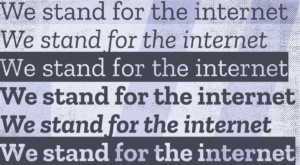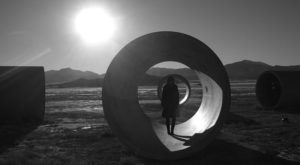Over the past few weeks, we’ve been exploring different iterations of our brand identity system. We know we need a solution that represents both who Mozilla is today and where we’re going in the future, and appeals both to people who know Mozilla well and new audiences who may not know or understand Mozilla yet. If you’re new to this project, you can read all about our journey on our blog, and the most recent post about the two different design directions that are informing this current round of work.
[TL;DR: Our “Protocol” design direction delivers well on our mission, legacy and vision to build an Internet as a global public resource that is healthy, open and accessible to all. Based on quantitative surveys, Mozillians and developers believe this direction does the best job supporting an experience that’s innovative, opinionated and inclusive, the attributes we want to be known for. In similar surveys, our target consumers evaluated our “Burst” design direction as the better option in terms of delivering on those attributes, and we also received feedback that this direction did a good job communicating interconnectedness and liveliness. Based on all of this feedback, our decision was to lead with the “Protocol” design direction, and explore ways to infuse it with some of the strengths of the “Burst” direction.]
Here’s an update on what we’ve been up to:
Getting to the heart of the matter
Earlier in our open design project, we conducted quantitative research to get statistically significant insights from our different key audiences (Mozillians, developers, consumers), and used these data points to inform our strategic decision about which design directions to continue to refine.
At this point of our open design project, we used qualitative research to understand better what parts of the refined identity system were doing a good job creating that overall experience, and what was either confusing or contradictory. We want Mozilla to be known and experienced as a non-profit organization that is innovative, opinionated and inclusive, and our logo and other elements in our brand identity system – like color, language and imagery – need to reinforce those attributes.
So we recruited participants in the US, Brazil, Germany and India between the ages of 18 – 40 years, who represent our consumer target audience: people who make decisions about the companies they support based on their personal values and ideals, which are driven by bettering their communities and themselves. 157 people participated (average about 39 from each country), with a split between 49% men and 51% women. 69% were between 18 – 34 years, and 90% had some existing awareness of Mozilla.
For 2 days, they interacted with an online moderator and had the opportunity to see and respond to others’ opinions in real time.
Learnings from this qualitative research are not intended to provide statistical analysis on which identity system was “the winner.” Instead respondents talk about what they’re seeing, while the moderator uncovers trends within these comments, and dives deeper into areas that are either highly favorable or unfavorable by asking “why?” This type of research is particularly valuable at our stage of an identity design process – where we’ve identified the strategic idea, and are figuring out the best way to bring it to life. Consumers not intimately familiar with Mozilla view the brand identity system with fresh eyes, helping illuminate any blind spots and provide insights into what helps new audiences better understand us.
Tapping into internal experts
Another extremely important set of stakeholders who have provided insights throughout the entire project, and especially at this stage, is our brand advisory group, composed of technologists, designers, strategists and community representatives from throughout Mozilla. This team was responsible not only for representing their “functional” area, but also accountable for representing the community of Mozillians across the world. We met every two weeks, sharing work-in-progress and openly and honestly discussing the merits and misses of each design iteration.
In addition to regular working sessions, we also asked our brand advisory group members to represent the work with their own networks, field questions, and surface concerns. At one point, one of our technology representatives called out that several developers and engineers did not understand the strategic intent and approach to project, and needed a better framework by which to evaluate the work in progress. So we convened this group for a frank and freewheeling conversation, and everyone —the design team included — walked away with a much deeper appreciation for the opportunities and challenges.
That exchange inspired us to host a series of “brown bag” conversations, open to all staff and volunteer Mozillians. During one week in October, we hosted five 60-minute sessions, as early as 7am PT and as late as 8pm PT to accommodate global time zones and participants. We also videotaped one session and made that available on AirMozilla, our video network, for those unable to attend in person. Throughout those 5 days, over 150 people participated in those critique sessions, which proved to be rich with constructive ideas.
The important thing to note is that these “brown bag” sessions were not driving toward consensus, but instead invited critical examination and discussion of the work based on a very explicit set of criteria. Similar to the qualitative research conducted with our target consumer audience, these discussions allowed us to ask “why” and “why not” and truly understand emotional reactions in a way that quantitative surveys aren’t able to do.
The participation and contribution of our brand advisory group has been invaluable. They’ve been tough critics, wise counsel, patient sounding boards, trusted eyes and ears and ultimately, strategic partners in guiding the brand identity work. They’re helping us deliver a solution that has global appeal, is technically beautiful, breaks through the clutter and noise, scales across all of our products, technologies, programs, and communities, and is fit for the future. Most importantly, they have been an important barometer in designing a system that is both true to who we are and pushes us to where we want to go.
Closing in on a recommendation
The feedback from the qualitative consumer research indicates that the new brand identity reinforces the majority of the key attributes we want Mozilla to represent. Along with insights from our brand advisory group and leadership, this feedback helps direct our work as we move to a final recommendation and find the right balance between bold and welcoming. Our goal is to share an update at our All Hands meeting in early December, almost exactly six months from the date we first shared options for strategic narratives to kick off the work. Following that, we’ll post it here as well.











Dmitry K Valberg wrote on
Jake wrote on
Scott McKellam wrote on
BTL wrote on
Mary Ellen Muckerman wrote on